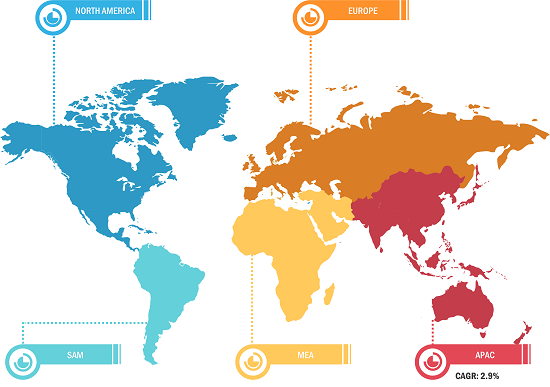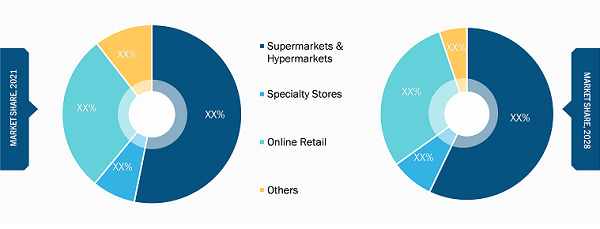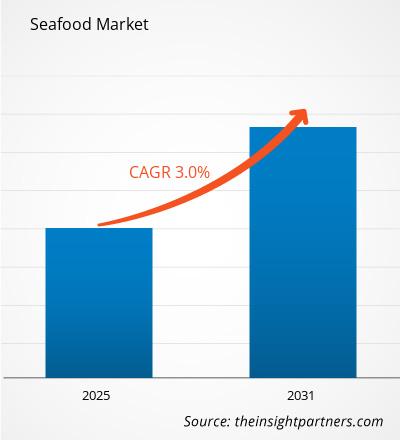Le marché des produits de la mer devrait passer de 1 71 493,93 millions de dollars américains en 2022 à 1 71 493,93 millions de dollars américains. 2 01 253,49 millions d’ici 2031 ; il devrait croître à un TCAC de 3,0 % entre 2022 et 2031.
La Food and Drug Administration (FDA) a déclaré que les fruits de mer englobent tous les poissons d'eau salée et d'eau douce, les mollusques et les crustacés obtenus dans le commerce. La demande de produits de la mer devrait connaître une croissance spectaculaire à travers le monde en raison de ses bienfaits pour la santé. Selon l'Organisation des Nations Unies pour l'alimentation et l'agriculture (FAO), d'ici 2030, une valeur supplémentaire de 40 millions de tonnes de produits de la mer, soit une augmentation d'environ 30 %, sera nécessaire pour répondre à la demande croissante des années à venir. En outre, l'augmentation de la consommation par habitant, accompagnée par la demande de produits de la mer importés de la nation riche, devrait soutenir la croissance du marché au cours de la période de prévision.
La région Asie-Pacifique détenait la plus grande part du marché des fruits de mer en 2021. Des pays comme le Japon, la Chine et la Corée du Sud ont une importance traditionnelle pour le poisson dans leurs cultures ; par conséquent, la forte demande de poisson dans ces pays est susceptible d’alimenter la croissance de l’industrie des produits de la mer. En plus des fruits de mer frais, les fruits de mer en conserve sont également très appréciés par la population de la région. Par exemple, le thon est très populaire parmi les Asiatiques en raison de son goût attrayant et de sa capacité à se marier avec de multiples saveurs. Les produits de thon en conserve présentent des saveurs uniques par rapport aux produits conventionnels qui pénètrent le marché APAC. En outre, le système de distribution amélioré avec les services de commerce électronique croissants stimule la croissance du marché des produits de la mer.
Aperçus stratégiques
Répartition du marché des fruits de mer - par région

Informations sur le marché
Demande accrue de fruits de mer surgelés et en conserve
Avec la demande croissante de fruits de mer transformés, le marché des produits de la mer surgelés et en conserve connaît une croissance rapide à travers le monde. Les produits de la mer surgelés sont transformés par congélation, ce qui aide à prévenir la forme bactérienne des produits alimentaires et augmente leur durée de conservation. De même, le poisson en conserve est transformé et conservé dans un récipient scellé et hermétique tel qu'une boîte de conserve en aluminium ou en fer blanc. Le poisson en conserve a généralement une durée de conservation de 1 à 5 ans. Les produits de la mer en conserve gagnent en popularité auprès des consommateurs en raison de la demande croissante de plats cuisinés. De même, les fruits de mer surgelés sont également accueillis positivement par les consommateurs, ce qui propulse la croissance du marché. Avec l’introduction de technologies émergentes, les fruits de mer surgelés conservent une valeur nutritionnelle et un goût similaires à ceux des fruits de mer frais. La congélation ralentit le processus de décomposition, conservant ainsi sa valeur nutritionnelle. Le poisson congelé quelques heures après sa capture contient des vitamines bien conservées. Il a été constaté que le poisson frais se dégrade rapidement et a une durée de conservation plus courte. Par conséquent, le besoin croissant de commodité et la durée de conservation accrue offerte par les produits de la mer en conserve et surgelés, associés à l'augmentation des activités de R&D des principaux acteurs, stimulent la croissance du marché des fruits de mer à travers le monde.
Informations basées sur les types de produits
< p>En fonction du type de produit, le marché des fruits de mer est segmenté en poissons, crustacés, mollusques et autres. Le segment des crustacés devrait enregistrer le TCAC le plus élevé au cours de la période de prévision. Les crustacés font partie du sous-phylum des crustacés (phylum Arthropoda), un groupe d'animaux invertébrés comprenant environ 45 000 espèces à travers le monde. Le groupe des crustacés comprend certains fruits de mer couramment consommés tels que le crabe, les crevettes, les homards, les crevettes, les écrevisses, le krill et les balanes. Ils aident à perdre du poids, aident à renforcer l’immunité et favorisent la chaleur et l’immunité. santé du cerveau. Crabe au curry & les dumplings, le homard newburg, les crevettes en pot, le moeche, la bisque de crevettes, les crevettes aux céréales et les soupes de crabe sont quelques-uns des plats les plus célèbres préparés à partir de crustacés et sont consommés partout dans le monde.Informations sur les canaux de distribution
En fonction de la distribution, le marché des produits de la mer est segmenté en supermarchés et hypermarchés, magasins spécialisés, vente au détail en ligne et autres. Les supermarchés & Le segment des hypermarchés détenait la plus grande part du marché des fruits de mer en 2021. Les supermarchés et les hypermarchés font référence aux magasins de libre-service qui proposent une grande variété de produits à la vente. Les produits de la mer disposent d'une section dédiée dans les supermarchés et hypermarchés. Ainsi, les clients disposent d'une grande variété d'options, notamment dans la section congélateur. Les comptoirs de fruits de mer des supermarchés et des hypermarchés sont considérés comme d’excellents endroits pour acheter une grande variété de fruits de mer frais et surgelés. Ces facteurs devraient stimuler la croissance du segment.
Marché des fruits de mer, par canal de distribution - 2022 et 2031 < /strong>
< /strong>
Quelques-uns des principaux acteurs opérant sur le marché des fruits de mer sont American Seafoods Company LLC, Kangamiut Seafood A/C, Lee Fishing Company, Pacific American Fish Co. Inc., Royal Greenland A/S, Mowi ASA, The Union Group PCL, Grupo Nueva Pescanova, Trident Seafoods Corporation et SeaPak Shrimp. & Entreprise de fruits de mer. Ces acteurs s'engagent à développer des produits présentant des risques sanitaires réduits pour répondre aux nouvelles tendances de consommation et respecter les cadres réglementaires. Ils sont impliqués dans des fusions et acquisitions, des expansions commerciales et des partenariats pour accroître leur part de marché.
Pleins feux sur les rapports
- Tendances progressistes de l'industrie sur le marché des produits de la mer pour aider les acteurs à développer des stratégies efficaces à long terme
- Stratégies de croissance des entreprises adoptées pour assurer une croissance sur les marchés développés et en développement
- Analyse quantitative du marché des fruits de mer de 2022 à 2031
- Estimation de la demande mondiale de produits de la mer
- Analyse des cinq forces de Porter pour illustrer l'efficacité des acheteurs et des fournisseurs opérant dans le secteur
- Développements récents pour comprendre le scénario de marché concurrentiel
- Tendances et perspectives du marché, et facteurs régissant la croissance du marché des fruits de mer
- Aide au processus de prise de décision en mettant en évidence les stratégies de marché qui soutiennent l'intérêt commercial, conduisant à la croissance du marché
- Taille du marché des fruits de mer à différents nœuds
- Aperçu détaillé et segmentation du marché et de la dynamique de l'industrie agroalimentaire
- Taille de la croissance dans diverses régions offrant des opportunités de croissance prometteuses
- Analyse historique (2 ans), année de base, prévision (7 ans) avec TCAC
- Analyse PEST et SWO
- Taille du marché Valeur / Volume - Mondial, Régional, Pays
- Industrie et paysage concurrentiel
- Ensemble de données Excel



Report Coverage
Revenue forecast, Company Analysis, Industry landscape, Growth factors, and Trends

Segment Covered
This text is related
to segments covered.

Regional Scope
North America, Europe, Asia Pacific, Middle East & Africa, South & Central America

Country Scope
This text is related
to country scope.
Questions fréquemment posées
The major players operating in the global seafood market are American Seafoods Company LLC, Kangamiut Seafood A/C, Lee Fishing Company, Pacific American Fish Co. Inc., Royal Greenland A/S, Mowi ASA, The Union Group PCL, Grupo Nueva Pescanova, Trident Seafoods Corporation, SeaPak Shrimp & Seafood Company among many others.
In 2019, the Asia Pacific held the largest share of the global seafood market. Asia Pacific is a mature and well-established market for seafood. Countries such as Japan, China, and South Korea have a traditional significance of fish in their cultures, and hence, the high demand for fish in these countries is likely to fuel the growth of the seafood market. In addition to fresh seafood, canned seafood is also highly embraced by the region’s population. For instance, tuna is highly popular among the Asian people attributed to its appealing taste and ability to blend well with multiple flavors. The canned tuna products penetrating the Asian market are exhibiting unique flavors apart from the conventional ones. However, in recent years the canned tuna sales in the region have been declining due to the consumers swaying towards other seafood, particularly shellfish. Thus, the manufacturers have been innovating their products in terms of base ingredients that can attract consumers. However, in Australia, canned tuna sales are escalating.
The growth of the crustaceans type segment is primarily attributed to the fact as many species of crustaceans are found in freshwater, seawater and also in inland brines. The crustaceans group include some commonly consumed seafoods like crab, shrimp, lobsters, prawns, crayfish, krill and barnacles. These crustaceans develop form larvae and bear segmented, split limbs or appendages. The fisheries in many parts of the world capture prawns, shrimps, spiny lobsters and king crabs, especially from the Northern Pacific and its southern counterparts. Many species of true crabs like the blue crab, Dungeness crab and stone crab serves as a valuable source of food. Crustaceans are consumed as seafoods as they are loaded with lean proteins, micronutrients and healthy fats. They aid in weight loss, helps in boosting immunity and promotes heat & brain health.
Trends and growth analysis reports related to Food and Beverages : READ MORE..
The List of Companies - Global Seafood Market
- American Seafoods Company LLC
- Kangamiut Seafood A/C
- Lee Fishing Company
- Pacific American Fish Co. Inc.
- Royal Greenland A/S
- Mowi ASA
- The Union Group PCL
- Grupo Nueva Pescanova
- Trident Seafoods Corporation
- SeaPak Shrimp & Seafood Company
The Insight Partners performs research in 4 major stages: Data Collection & Secondary Research, Primary Research, Data Analysis and Data Triangulation & Final Review.
- Data Collection and Secondary Research:
As a market research and consulting firm operating from a decade, we have published and advised several client across the globe. First step for any study will start with an assessment of currently available data and insights from existing reports. Further, historical and current market information is collected from Investor Presentations, Annual Reports, SEC Filings, etc., and other information related to company’s performance and market positioning are gathered from Paid Databases (Factiva, Hoovers, and Reuters) and various other publications available in public domain.
Several associations trade associates, technical forums, institutes, societies and organization are accessed to gain technical as well as market related insights through their publications such as research papers, blogs and press releases related to the studies are referred to get cues about the market. Further, white papers, journals, magazines, and other news articles published in last 3 years are scrutinized and analyzed to understand the current market trends.
- Primary Research:
The primarily interview analysis comprise of data obtained from industry participants interview and answers to survey questions gathered by in-house primary team.
For primary research, interviews are conducted with industry experts/CEOs/Marketing Managers/VPs/Subject Matter Experts from both demand and supply side to get a 360-degree view of the market. The primary team conducts several interviews based on the complexity of the markets to understand the various market trends and dynamics which makes research more credible and precise.
A typical research interview fulfils the following functions:
- Provides first-hand information on the market size, market trends, growth trends, competitive landscape, and outlook
- Validates and strengthens in-house secondary research findings
- Develops the analysis team’s expertise and market understanding
Primary research involves email interactions and telephone interviews for each market, category, segment, and sub-segment across geographies. The participants who typically take part in such a process include, but are not limited to:
- Industry participants: VPs, business development managers, market intelligence managers and national sales managers
- Outside experts: Valuation experts, research analysts and key opinion leaders specializing in the electronics and semiconductor industry.
Below is the breakup of our primary respondents by company, designation, and region:

Once we receive the confirmation from primary research sources or primary respondents, we finalize the base year market estimation and forecast the data as per the macroeconomic and microeconomic factors assessed during data collection.
- Data Analysis:
Once data is validated through both secondary as well as primary respondents, we finalize the market estimations by hypothesis formulation and factor analysis at regional and country level.
- Macro-Economic Factor Analysis:
We analyse macroeconomic indicators such the gross domestic product (GDP), increase in the demand for goods and services across industries, technological advancement, regional economic growth, governmental policies, the influence of COVID-19, PEST analysis, and other aspects. This analysis aids in setting benchmarks for various nations/regions and approximating market splits. Additionally, the general trend of the aforementioned components aid in determining the market's development possibilities.
- Country Level Data:
Various factors that are especially aligned to the country are taken into account to determine the market size for a certain area and country, including the presence of vendors, such as headquarters and offices, the country's GDP, demand patterns, and industry growth. To comprehend the market dynamics for the nation, a number of growth variables, inhibitors, application areas, and current market trends are researched. The aforementioned elements aid in determining the country's overall market's growth potential.
- Company Profile:
The “Table of Contents” is formulated by listing and analyzing more than 25 - 30 companies operating in the market ecosystem across geographies. However, we profile only 10 companies as a standard practice in our syndicate reports. These 10 companies comprise leading, emerging, and regional players. Nonetheless, our analysis is not restricted to the 10 listed companies, we also analyze other companies present in the market to develop a holistic view and understand the prevailing trends. The “Company Profiles” section in the report covers key facts, business description, products & services, financial information, SWOT analysis, and key developments. The financial information presented is extracted from the annual reports and official documents of the publicly listed companies. Upon collecting the information for the sections of respective companies, we verify them via various primary sources and then compile the data in respective company profiles. The company level information helps us in deriving the base number as well as in forecasting the market size.
- Developing Base Number:
Aggregation of sales statistics (2020-2022) and macro-economic factor, and other secondary and primary research insights are utilized to arrive at base number and related market shares for 2022. The data gaps are identified in this step and relevant market data is analyzed, collected from paid primary interviews or databases. On finalizing the base year market size, forecasts are developed on the basis of macro-economic, industry and market growth factors and company level analysis.
- Data Triangulation and Final Review:
The market findings and base year market size calculations are validated from supply as well as demand side. Demand side validations are based on macro-economic factor analysis and benchmarks for respective regions and countries. In case of supply side validations, revenues of major companies are estimated (in case not available) based on industry benchmark, approximate number of employees, product portfolio, and primary interviews revenues are gathered. Further revenue from target product/service segment is assessed to avoid overshooting of market statistics. In case of heavy deviations between supply and demand side values, all thes steps are repeated to achieve synchronization.
We follow an iterative model, wherein we share our research findings with Subject Matter Experts (SME’s) and Key Opinion Leaders (KOLs) until consensus view of the market is not formulated – this model negates any drastic deviation in the opinions of experts. Only validated and universally acceptable research findings are quoted in our reports.
We have important check points that we use to validate our research findings – which we call – data triangulation, where we validate the information, we generate from secondary sources with primary interviews and then we re-validate with our internal data bases and Subject matter experts. This comprehensive model enables us to deliver high quality, reliable data in shortest possible time.

 Obtenez un échantillon gratuit pour ce rapport
Obtenez un échantillon gratuit pour ce rapport